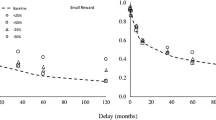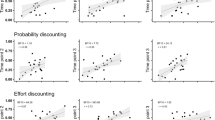Abstract
Delay discounting refers to the fact that an immediate reward is valued more than the same reward if it occurs some time in the future. To examine the neural substrates underlying this process, we studied 13 healthy volunteers who repeatedly had to decide between an immediate and parametrically varied delayed hypothetical reward using a delay discounting task during event-related functional magnetic resonance imaging. Subject’s preference judgments resulted in different discounting slopes for shorter (<1 year) and for longer (≥1 year) delays. Neural activation associated with the shorter delays relative to the longer delays was associated with increased activation in the head of the left caudate nucleus and putamen. When individuals selected the delayed relative to the immediate reward, a strong activation was found in bilateral posterior insular cortex. Several brain areas including the left caudate nucleus showed a correlation between the behaviorally determined discounting and brain activation for the contrast of intervals with delays <1 and ≥1 year. These results suggest that (1) the posterior insula, which is a critical component of the decision-making neural network, is involved in delaying gratification and (2) the degree of neural activation in the striatum, which plays a fundamental role in reward prediction and in time estimation, may code for the time delay.






Similar content being viewed by others
References
Ainslee G (1975) Specious reward: a behavioral theory of impulsiveness and impulse control. Psychol Bull 82:463–496
Baker F, Johnson M, Bickel W (2003) Delay discounting in current and never before cigarette smokers: similarities and differences across commodity, sign, and magnitude. J Abnorm Psychol 112:382–392
Barkley R, Edwards G, Laneri M, Fletcher K, Metevia L (2001) Executive functioning, temporal discounting, and sense of time in adolescents with attention deficit hyperactivity disorder (ADHD) and oppositional defiant disorder (ODD). J Abnorm Child Psychol 29:541–556
Barratt E (1983) The biological basis of impulsiveness: the significance of timing and rhythm disorders. Pers Individ Dif 4:387–391
Bechara A (2004) Disturbances of emotion regulation after focal brain lesions. Int Rev Neurobiol 62:159–193
Bickel W, Odum A, Madden G (1999) Impulsivity and cigarette smoking: delay discounting in current, never, and ex-smokers. Psychopharmacology 146:447–454
Bowman EM, Brown VJ (1998) Effects of excitotoxic lesions of the rat ventral striatum on the perception of reward cost. Exp Brain Res 123:439–448
Camerer C, Hogarth R (1999) The effects of financial incentives in experiments: a review and capital-labor-production framework. J Risk Uncertain 19:7–42
Cardinal R (2001) Impulsive choice induced in rats by lesions of the nucleus accumbens core. Science 292:2499–2501
Cardinal RN, Winstanley CA, Robbins TW, Everitt BJ (2004) Limbic corticostriatal systems and delayed reinforcement. Ann NY Acad Sci 1021:33–50
Cox RW (1996) AFNI: software for analysis and visualization of functional magnetic resonance neuroimages. Comput Biomed Res 29:162–173
Craig AD (2002) How do you feel? Interoception: the sense of the physiological condition of the body. Nat Rev Neurosci 3:655–666
Critchley HD, Mathias CJ, Dolan RJ (2001) Neural activity in the human brain relating to uncertainty and arousal during anticipation. Neuron 29:537–545
Cromwell HC, Hassani OK, Schultz W (2005) Relative reward processing in primate striatum. Exp Brain Res 162:520–525
Cuoll JT, Vidal F, Nazarin B, Macar F (2004) Functional anatomy of the attentional modulation of time estimation. Science 303:1506–1508
Doya K (2002) Metalearning and neuromodulation. Neural Netw 15:495–506
Elliott R, Friston KJ, Dolan RJ (2000) Dissociable neural responses in human reward systems. J Neurosci 20:6159–6165
Ernst M, Bolla K, Mouratidis M, Contoreggi C, Matochik JA, Kurian V, Cadet JL, Kimes AS, London ED (2002) Decision-making in a risk-taking task: a PET study. Neuropsychopharmacology 26:682–691
Evenden JL (1999) Impulsivity: a discussion of clinical and experimental findings. J Psychopharmacol 13:180–192
Hassani OK, Cromwell HC, Schultz W (2001) Influence of expectation of different rewards on behavior-related neuronal activity in the striatum. J Neurophysiol 85:2477–2489
Hinton S, Meck W (2004) Frontal-striatal circuitry activated by human peak-interval timing in the supra-seconds range. Cogn Brain Res 21:171–182
Holt CA, Laury SK (2001) Varying the scale of financial incentives under real and hypothetical conditions. Behav Brain Sci 24:417–418
Horn NR, Dolan M, Elliott, Deakin JFW, Woodruff PWR (2003) Response inhibition and impulsivity: an fMRI study. Neuropsychologia 41:1959–1966
Kahneman D, Tversky A (1979) Prospect theory: an analysis of decision under risk. Econometrica 47:263–291
Kirby K, Petry N, Bickel W (1999). Heroin addicts have higher discount rates for delayed rewards than non-drug-using controls. J Exp Psychol Gen 128:78–87
Kirby KN, Santiesteban M (2003) Concave utility, transaction costs, and risk in measuring discounting of delayed rewards. J Exp Psychol Learn Mem Cogn 29:66–79
Knutson B, Westdorp A, Kaiser E, Hommer D (2000) FMRI visualization of brain activity during a monetary incentive delay task. Neuroimage 12:20–27
Laibson D (1997) Golden eggs and hyperbolic discounting. Q J Econ 112:443–477
Lane S, Cherek D, Pietras C, Tcheremissine O (2003) Measurement of delay discounting using trial-by-trial consequences. Behav Process 64:287–303
Madden G, Bickel W, Jacobs E (1999) Discounting of delayed rewards in opioid-dependent outpatients: exponential or hyperbolic discounting functions? Exp Clin Psychopharmacol 7:284–293
Madden G, Begotka A, Raiff B, Kastern L (2003). Delay discounting of real and hypothetical rewards. Exp Clin Psychopharmacol 11:139–145
Madden G, Raiff B, Lagorio C, Begotka A, Mueller A, Hehli D, Wegener A (2004). Delay discounting of potentially real and hypothetical rewards: II. Between- and within-subject comparisons. Exp Clin Psychopharmacol 12:251–261
McClure S, Laibson D, Loewenstein G, Cohen J (2004) Separate neural systems value immediate and delayed monetary rewards. Science 306:503–507
McCoy A, Platt M (2003) Expectations and outcomes: decision-making in the primate brain. J Comp Physiol A 191:201–211
McCoy A, Crowley J, Haghighian G, Dean H, Platt M (2003) Saccade reward signals in posterior cingulate cortex. Neuron 40:1031–1040
Nenadic I, Gaser C, Volz H-P, Rammsayer T, Häger F, Sauer H (2003) Processing of temporal information and the basal ganglia: new evidence from fMRI. Exp Brain Res 148:238–246
Pagnoni G, Zink CF, Montague PR, Berns GS (2002) Activity in human ventral striatum locked to errors of reward prediction. Nat Neurosci 5:97–98
Paulus MP, Frank LR (2003) Ventromedial prefrontal cortex activation is critical for preference judgments. Neuroreport 14:1311–1315
Paulus MP, Hozack N, Zauscher B, McDowell JE, Frank L, Brown GG, Braff DL (2001) Prefrontal, parietal, and temporal cortex networks underlie decision-making in the presence of uncertainty. Neuroimage13:91–100
Paulus MP, Rogalsky C, Simmons A, Feinstein J, Stein MB (2003) Increased activation in the right insula during risk-taking decision-making is related to harm avoidance and neuroticism. Neuroimage 19:1439–1448
Petry N, Bickel W, Arnett M (1998) Shortened time horizons and insensitivity to future consequences in heroin addicts. Addiction 93:729–738
Rachlin H (1992) Diminishing marginal value as delay discounting. J Exp Anal Behav 57:407–415
Reynolds B, Schiffbauer R (2004) Measuring state changes in human delay discounting: an experiential discounting task. Behav Process 67:343–356
Rubia K, Taylor E, Smith AB, Oksannen H, Overmeyer S, Newman S (2001) Neuropsychological analyses of impulsiveness in childhood hyperactivity. Br J Psychiatry 179:138–143
Small D, Gitelman D, Simmons K, Bloise SM, Parrish T, Mesulam MM (2005) Monetary incentives enhance processing in brain regions mediating top-down control of attention. Cereb Cortex 11:954–965
Spitzer RL, Williams JB, Gibbon M, First MB (1992) The structured clinical interview for DSM-III–R (SCID): I. History, rationale, and description. Arch Gen Psychiatry 49:624–629
Talairach J, Tournoux (1988) Co-planar stereotaxic atlas of the human brain. Thieme Medical, Stuttgart
Tanaka S, Doya K, Okada G, Ueda K, Okamoto Y, Yamawaki S (2004) Prediction of immediate and future rewards differentially recruits cortico-basal ganglia loops. Nat Neurosci 7:887–893
Trope Y, Liberman N (2000) Temporal construal and time-dependent changes in preference. J Pers Soc Psychol 79:876–889
Vogt BA, Finch DM, Olson CR (1992) Functional heterogeneity in cingulate cortex: the anterior executive and posterior evaluative regions. Cereb Cortex 2:435–443
Volz KG, Schubotz RI, von Cramon DY (2003) Predicting events of varying probability: uncertainty investigated by fMRI. Neuroimage 19:271–80
Vuchinich RE, Simpson CA (1998) Hyperbolic temporal discounting in social drinkers and problem drinkers. Exp Clin Psychopharmacol 6:292–305
Acknowledgments
We would like to acknowledge the invaluable help of Kelly Winternheimer and Thuy Le in conducting the experiments. Thanks are due to Justin Feinstein whose suggestions have greatly improved the presentation of this study. The Max Kade Foundation who supported M. Wittmann by a grant is also gratefully acknowledged. This work was supported by a grant from NIMH (R21DA13186, R01DA016663), by a VA Merit Grant and by support from the UCSD GCRC (M01 RR00827).
Author information
Authors and Affiliations
Corresponding author
Rights and permissions
About this article
Cite this article
Wittmann, M., Leland, D.S. & Paulus, M.P. Time and decision making: differential contribution of the posterior insular cortex and the striatum during a delay discounting task. Exp Brain Res 179, 643–653 (2007). https://doi.org/10.1007/s00221-006-0822-y
Received:
Accepted:
Published:
Issue Date:
DOI: https://doi.org/10.1007/s00221-006-0822-y




